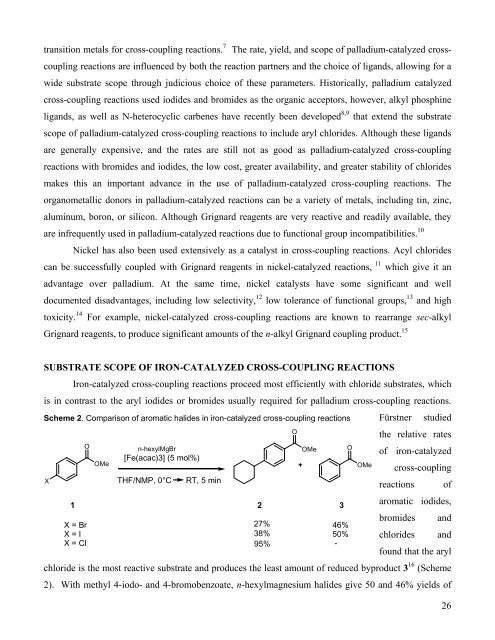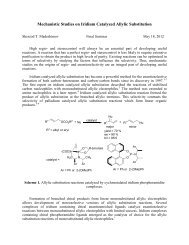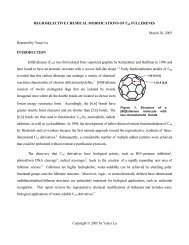Metal-Catalyzed Cross-Coupling Reactions: Entering the Iron
Metal-Catalyzed Cross-Coupling Reactions: Entering the Iron
Metal-Catalyzed Cross-Coupling Reactions: Entering the Iron
You also want an ePaper? Increase the reach of your titles
YUMPU automatically turns print PDFs into web optimized ePapers that Google loves.
transition metals for cross-coupling reactions. 7 The rate, yield, and scope of palladium-catalyzed cross-<br />
coupling reactions are influenced by both <strong>the</strong> reaction partners and <strong>the</strong> choice of ligands, allowing for a<br />
wide substrate scope through judicious choice of <strong>the</strong>se parameters. Historically, palladium catalyzed<br />
cross-coupling reactions used iodides and bromides as <strong>the</strong> organic acceptors, however, alkyl phosphine<br />
ligands, as well as N-heterocyclic carbenes have recently been developed 8,9 that extend <strong>the</strong> substrate<br />
scope of palladium-catalyzed cross-coupling reactions to include aryl chlorides. Although <strong>the</strong>se ligands<br />
are generally expensive, and <strong>the</strong> rates are still not as good as palladium-catalyzed cross-coupling<br />
reactions with bromides and iodides, <strong>the</strong> low cost, greater availability, and greater stability of chlorides<br />
makes this an important advance in <strong>the</strong> use of palladium-catalyzed cross-coupling reactions. The<br />
organometallic donors in palladium-catalyzed reactions can be a variety of metals, including tin, zinc,<br />
aluminum, boron, or silicon. Although Grignard reagents are very reactive and readily available, <strong>the</strong>y<br />
are infrequently used in palladium-catalyzed reactions due to functional group incompatibilities. 10<br />
Nickel has also been used extensively as a catalyst in cross-coupling reactions. Acyl chlorides<br />
can be successfully coupled with Grignard reagents in nickel-catalyzed reactions, 11 which give it an<br />
advantage over palladium. At <strong>the</strong> same time, nickel catalysts have some significant and well<br />
documented disadvantages, including low selectivity, 12 low tolerance of functional groups, 13 and high<br />
toxicity. 14 For example, nickel-catalyzed cross-coupling reactions are known to rearrange sec-alkyl<br />
Grignard reagents, to produce significant amounts of <strong>the</strong> n-alkyl Grignard coupling product. 15<br />
SUBSTRATE SCOPE OF IRON-CATALYZED CROSS-COUPLING REACTIONS<br />
<strong>Iron</strong>-catalyzed cross-coupling reactions proceed most efficiently with chloride substrates, which<br />
is in contrast to <strong>the</strong> aryl iodides or bromides usually required for palladium cross-coupling reactions.<br />
Scheme 2. Comparison of aromatic halides in iron-catalyzed cross-coupling reactions<br />
X<br />
O<br />
OMe<br />
1 2<br />
X = Br<br />
X = I<br />
X = Cl<br />
n-hexylMgBr<br />
[Fe(acac)3] (5 mol%)<br />
THF/NMP, 0°C<br />
RT, 5 min<br />
Fürstner studied<br />
<strong>the</strong> relative rates<br />
of iron-catalyzed<br />
cross-coupling<br />
reactions of<br />
aromatic iodides,<br />
bromides and<br />
chlorides and<br />
found that <strong>the</strong> aryl<br />
chloride is <strong>the</strong> most reactive substrate and produces <strong>the</strong> least amount of reduced byproduct 3 16 (Scheme<br />
2). With methyl 4-iodo- and 4-bromobenzoate, n-hexylmagnesium halides give 50 and 46% yields of<br />
O<br />
OMe<br />
27%<br />
46%<br />
38%<br />
50%<br />
95% -<br />
3<br />
O<br />
OMe<br />
26






